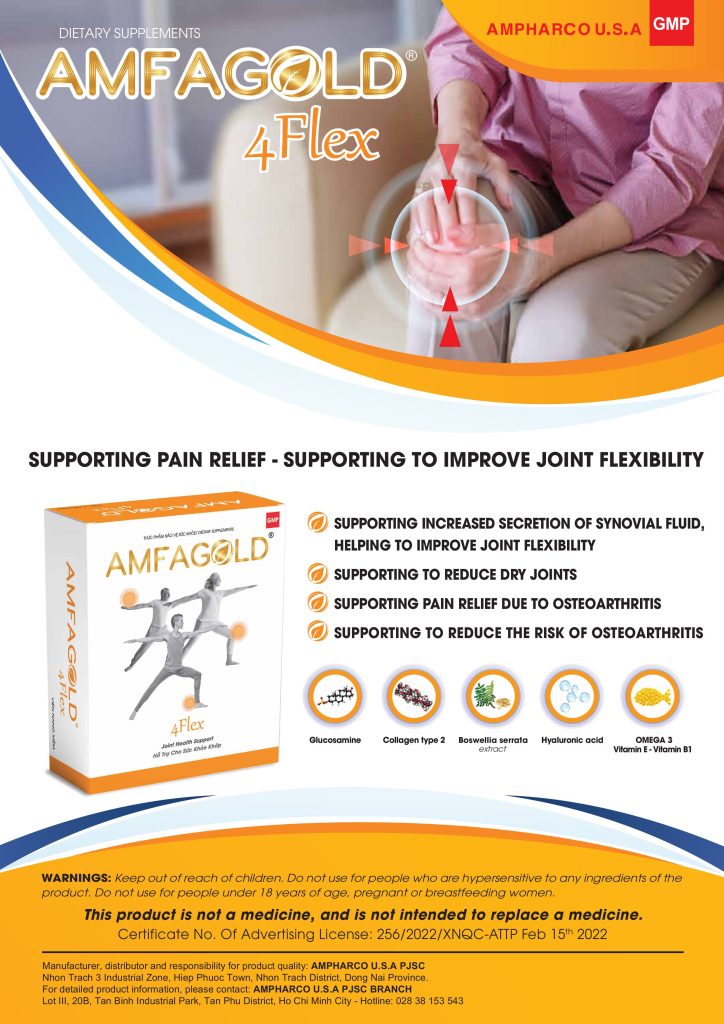THE GOLDEN SOLUTION FOR JOINT HEALTH IN WOMEN 50+
1/ JOINT ISSUES IN WOMEN OVER 50

Osteoarthritis – A Silent Threat
Women over 50 often face joint-related issues such as osteoarthritis, osteoporosis, and arthritis. According to the World Health Organization (WHO), osteoarthritis is the leading cause of disability among middle-aged and elderly individuals, particularly affecting women over 55 years old (1). The decline in estrogen levels significantly reduces bone density and affects cartilage function, leading to joint pain that impacts both health and financial well-being (2).
Common Symptoms of Osteoarthritis (3)
There are three primary symptoms commonly seen in individuals with osteoarthritis:
- Pain and stiffness: The pain is mechanical in nature, meaning it worsens with movement and improves with rest. However, if left untreated, the pain may become persistent and more severe over time.
- Joint noises: Many osteoarthritis patients experience cracking or grinding sounds when moving their joints. Some individuals hear these sounds every time they stand up, sit down, or perform any movement.
- Swelling and inflammation in advanced stages: In later stages, the affected joint may become swollen due to inflammatory osteoarthritis. This occurs when cartilage fragments break off and enter the joint cavity, causing trauma to the synovial membrane. As a result, the joint may swell and accumulate excess fluid (joint effusion). In more severe cases, muscle atrophy, joint looseness, or even dislocation can occur.
Current Treatment Methods
Currently, nonsteroidal anti-inflammatorydrugs (NSAIDs) are the most commonly used treatment for joint pain, helping to manage symptoms. However, research from the American College of Rheumatology indicates that NSAIDs may cause side effects such as stomach ulcers, kidney problems, high blood pressure, and heart-related issues (4).
As a result, natural joint-supporting nutrients are becoming an increasingly popular trend, offering a safe and sustainable approach to joint protection.
2/ THE GOLDEN SOLUTION FOR JOINT PROTECTION
Let’s explore the most effective solutions for protecting joint health:
-
Boswellia Serrata – The Natural Anti-Inflammatory Warrior
Boswellia Serrata, also known as Indian Frankincense, is a precious medicinal herb with powerful anti-inflammatory properties due to its boswellic acids. A study published in PubMed Central found that acetyl-11-keto-β-boswellic acid (AKBA) from Boswellia inhibits the 5-lipoxygenase (5-LOX) enzyme, a key factor in osteoarthritis inflammation.
A clinical trial conducted by Raychaudhuri et al. in India revealed that Boswellia Serrata extract can significantly reduce knee pain and improve joint function, with some patients experiencing pain relief within just 7 days (5).

-
Hyaluronic Acid – Enhancing Smooth Joint Movement
According to Arthritis Health, Hyaluronic Acid (HA) is a gel-like substance naturally present in the body that plays a crucial role in treating various joint conditions and offers numerous joint health benefits (6):
- Lubrication for joints: Hyaluronic Acid binds well with water, creating a thick, gel-like consistency. This viscous fluid provides lubrication and acts as a shock absorber in the joints.
- Cartilage and bone growth: Hyaluronic Acid promotes the growth and development of cartilage and bones by stimulating the production of new cells and tissues.
- Inflammation reduction: Hyaluronic Acid plays an important role in reducing joint inflammation and pain caused by injury or tissue degeneration.
Hyaluronic Acid is most commonly used to treat knee osteoarthritis. Some doctors may recommend oral supplements alongside intra-articular injections as part of osteoarthritis treatment.

-
Glucosamine – Supporting Joint Pain Relief
According to PubMed, over the past 20 years, numerous studies have examined the effectiveness of glucosamine sulfate in improving symptoms (pain and joint function) and slowing the structural progression of osteoarthritis. Strong evidence suggests that a daily oral dose of 1,500 mg of glucosamine sulfate can significantly reduce osteoarthritis symptoms in the lower limbs.
This dosage has also been shown in two independent studies to prevent joint space narrowing in the femorotibial compartment of patients with mild-to-moderate knee osteoarthritis. This effect led to a 50% reduction in osteoarthritis-related surgeries in the lower limbs within five years after discontinuing treatment (7).
-
Collagen Type II – Restoring and Protecting Cartilage
A 12-week randomized, double-blind, placebo-controlled clinical study on 101 participants aged 40–65 with knee osteoarthritis evaluated the effectiveness of Type II Collagen (TII), glucosamine hydrochloride + chondroitin sulfate, and a placebo.
The results confirmed that Type II Collagen (TII) not only provides superior efficacy and high safety for knee osteoarthritis treatment but also significantly enhances patients’ quality of life (8).
-
Omega-3 – Reducing Inflammation and Protecting Joints
Inflammation is a complex biological process involving multiple cell types, chemical mediators, and biological interactions. Omega-3 fatty acids, such as EPA and DHA, found in fatty fish and fish oil, help reduce inflammation through various mechanisms (9):
- Inhibiting inflammatory factors: Omega-3 reduces leukocyte chemotaxis, adhesion molecule expression, and leukocyte-endothelial adhesive interactions.
- Decreasing the production of pro-inflammatory eicosanoids: Omega-3 suppresses the formation of prostaglandins and leukotrienes derived from arachidonic acid (n-6).
- Generating powerful anti-inflammatory compounds: EPA and DHA produce resolvins, protectins, and maresins, which help regulate and resolve inflammatory responses.
Conclusion
Joint pain affects millions worldwide, and choosing the right solutions can help minimize discomfort and significantly improve quality of life. Prioritizing natural, science-backed approaches can lead to long-term joint health and well-being.

References:
- https://www.who.int/news-room/fact-sheets/detail/osteoarthritis
- https://www.nature.com/articles/s41413-023-00280-x
- https://suckhoedoisong.vn/thoai-hoa-khop-co-bieu-hien-gi-169230313174607607.htm
- https://rheumatology.org/patients/nsaids-nonsteroidal-anti-inflammatory-drugs
- https://pmc.ncbi.nlm.nih.gov/articles/PMC3309643/
- https://www.arthritis-health.com/treatment/injections/what-hyaluronic-acid
- https://pmc.ncbi.nlm.nih.gov/articles/PMC3456914/#Sec2
- https://jeo-esska.springeropen.com/articles/10.1186/s40634-022-00559-8
- https://pubmed.ncbi.nlm.nih.gov/28900017/

- 1. BOSWELLIA AND HYALURONIC ACID AS AN EFFECTIVE SOLUTION FOR JOIN PAIN RELIEF
- 2. TIPS TO REDUCE NIGHTTIME JOINT PAIN FOR BETTER SLEEP
- 3. EASY EXERCISES FOR KNEE ARTHRITIS
- 4. How to Ease Osteoarthritis Pain Effectively
- 5. A EFFECTIVE SOLUTIONS FOR CONTROL OF OSTEOARTHRITIS
- 6. Boswellia: NSAID Alternative

